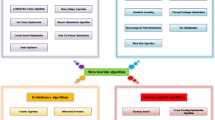Abstract
Mobile nodes in underwater wireless sensor networks are becoming very important as they not only enable flexible sensing areas but also entails the ability to provide means for data and energy sharing among existing static sensor nodes. In this paper, three efficient meta-heuristic evolutionary algorithms ant colony optimization, artificial bees colony and firefly algorithm, inspired by swarm intelligence are being compared with an objective to achieve the shortest path for the mobile node in traversing the complete sensing network. We transform this problem into the traveling salesman problem. It is the most famous and commonly used nondeterministic-polynomial combinatorial optimization problem in which an artificial agent is set to travel between different cities and calculate distance or time consumed to travel between these nodes or cities for best route selection. Heuristic and meta-heuristic algorithms are being used for decades to solve such type of problems. In this comparative study, an analysis of meta-heuristic algorithms for obtaining results in less processing time while searching for the optimal solution has been done. Moreover, this paper provides a classification of mentioned algorithms and highlights their characteristics. The experiment has been carried out on these algorithms by manipulating different parameters such as population and number of iteration.













Similar content being viewed by others
References
Gomez, A., Lagadec, M. F., Magno, M., & Benini, L. (2015). Self-powered wireless sensor nodes for monitoring radioactivity in contaminated areas using unmanned aerial vehicles. In 2015 IEEE sensors applications symposium (SAS) (pp. 1–6). IEEE.
Burgard, W., Moors, M., Fox, D., Simmons, R., & Thrun, S. (2000). Collaborative multi-robot exploration. In ICRA (pp. 476–481).
Cui, J.-H., Kong, J., Gerla, M., Zhou, S., et al. (2006). The challenges of building scalable mobile underwater wireless sensor networks for aquatic applications. IEEE Network, 20(3), 12.
Halim, A. H., & Ismail, I. (2017). Combinatorial optimization: Comparison of heuristic algorithms in travelling salesman problem. Archives of Computational Methods in Engineering, 26(2), 367–380.
Karaboga, D., & Akay, B. (2009). A survey: Algorithms simulating bee swarm intelligence. Artificial Intelligence Review, 31(1–4), 61.
Basu, S., Karuppiah, M., Selvakumar, K., Li, K.-C., Islam, S. H., Hassan, M. M., et al. (2018). An intelligent/cognitive model of task scheduling for iot applications in cloud computing environment. Future Generation Computer Systems, 88, 254–261.
Hassanien, A. E., & Emary, E. (2018). Swarm intelligence: Principles, advances, and applications. Boca Raton: CRC Press.
Selvi, V., & Umarani, D. R. (2010). Comparative analysis of ant colony and particle swarm optimization techniques. International Journal of Computer Applications, 5(4), 1–6.
Kewat, A., Gupta, A. K. S. P., & Srivastava, P. (2016). Evaluating the performance of ant colony algorithm for the solution of constraint based traveling salesman problem. International Journal of Engineering and Computer Science, 5(9), 17909–17915.
Dorigo, M., & Stützle, T. (2019). Ant colony optimization: overview and recent advances. In M. Gendreau & J.-Y. Potvin (Eds.), Handbook of metaheuristics (pp. 311–351). Berlin: Springer.
Li, W. H., Li, W. J., Yang, Y., Liao, H. Q., Li, J. L., & Zheng, X. P. (2011). Artificial bee colony algorithm for traveling salesman problem. In J. Gao (Ed.), Advanced Materials Research (Vol. 314, pp. 2191–2196). Stafa-Zurich: Trans Tech Publications Ltd.
Hu, J., & Fu, Y. (2015). Task scheduling model of cloud computing based on firefly algorithm. International Journal of Hybrid Information Technology, 8(8), 35–46.
Crama, Y., van de Klundert, J., & Spieksma, F. C. (2002). Production planning problems in printed circuit board assembly. Discrete Applied Mathematics, 123(1–3), 339–361.
Author information
Authors and Affiliations
Corresponding author
Additional information
Publisher's Note
Springer Nature remains neutral with regard to jurisdictional claims in published maps and institutional affiliations.
Rights and permissions
About this article
Cite this article
Zehra, S.S., Qureshi, R., Dev, K. et al. Comparative Analysis of Bio-Inspired Algorithms for Underwater Wireless Sensor Networks. Wireless Pers Commun 116, 1311–1323 (2021). https://doi.org/10.1007/s11277-020-07418-8
Published:
Issue Date:
DOI: https://doi.org/10.1007/s11277-020-07418-8
Keywords
- Underwater wireless sensor network (UWSN)
- Meta-heuristics
- Evolutionary algorithms
- Traveling salesman problem (TSP)
- Swarm intelligence (SI)
- Non-deterministic polynomial-hard problem (NP-hard)
- Combinatorial optimization problem (COP)
- Ant colony optimization (ACO)
- Artificial bees colony (ABC)
- Firefly algorithm (FFA)




